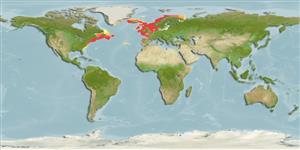Common names from other countries
Environment: milieu / climate zone / depth range / distribution range
Ecologie
; brakwater; diepteverspreiding 0 - 650 m (Ref. 114164), usually 0 - 400 m (Ref. 114164). Temperate; 72°N - 28°N, 81°W - 42°E
Arctic and Atlantic Ocean.
Length at first maturity / Size / Gewicht / Leeftijd
Maturity: Lm ? range ? - ? cm Max length : 52.0 cm WD mannelijk/geslacht niet bekend; (Ref. 101440)
Life cycle and mating behavior
Geslachtsrijpheid | Voortplanting | Kuitschieten | Eieren | Fecundity | Larven
Members of the class Asteroidea exhibit both asexual (regeneration and clonal) and sexual (gonochoric) means of reproduction. Life cycle: Embryos hatch into planktonic larvae and later metamorphose into pentamorous juveniles which develop into young sea stars with stubby arms.
Harms, J. 1993. (Ref. 2711)
Status op de Rode Lijst van het IUCN (Ref. 130435: Version 2024-1)
Status bij CITES (Ref. 108899)
Not Evaluated
Not Evaluated
Gebruik door de mens
Visserij: commercieel
FAO - Visserij: landings | FishSource | Sea Around Us
Tools
Internet-bronnen
Estimates based on models
Preferred temperature
(Ref.
115969): 6.3 - 10.2, mean 9.7 (based on 19 cells).
Kwetsbaarheid
Moderate vulnerability (41 of 100).
Prijsklasse
Unknown.
